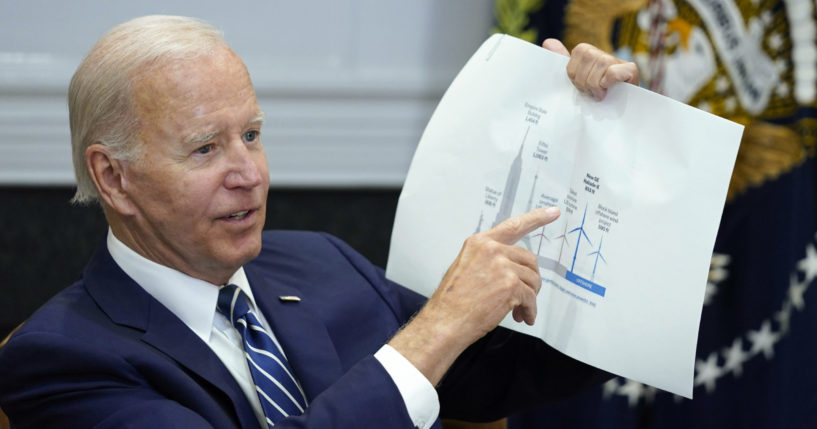
Biden's Newest Green Energy Scheme Involves Floating Ocean Platforms
The Biden administration Thursday announced plans to develop floating platforms in the deep ocean for wind towers that purportedly could power millions of homes.
The plan would target sites in the Pacific Ocean off the California and Oregon coasts, as well as in the Atlantic in the Gulf of Maine.
President Joe Biden hopes to deploy up to 15 gigawatts of electricity through floating sites by 2035, enough to power 5 million homes. The administration previously set a goal of 30 gigawatts of offshore wind by 2030 using the traditional technique of securing wind turbines to the ocean floor.
There are only a handful of floating offshore platforms in the world — all in Europe — but Biden administration officials said the technology is developing and could soon establish the United States as a global leader in offshore wind.
The push for offshore wind is part of Biden’s effort to promote clean energy and address “climate change.” The president has pledged to cut greenhouse gas emissions in half by 2030.
The Inflation Reduction Act, a climate-and-tax bill Biden signed last month, would spend about $375 billion over 10 years to boost electric vehicles, promote renewable energy such as solar and wind power and develop alternative energy sources like hydrogen.
“Today we’re launching efforts to seize a new opportunity — floating offshore wind — which will let us build in deep water areas where turbines can’t be secured directly to the sea floor, but where there are strong winds that we can now harness,” White House climate adviser Gina McCarthy said at a news conference Thursday.
Deepwater areas in the Pacific especially have potential to vastly expand offshore wind energy in the U.S., McCarthy and other officials said.
She acknowledged that the floating technology is at an early stage. But McCarthy said “coordinated actions” by federal and state officials, working with the private sector, can position the U.S. “to lead the world on floating offshore wind and bring offshore wind jobs to more parts of our country, including the West Coast.”
As part of our @Energy Earthshots program, we’re launching a Floating Offshore Wind Shot to reduce costs of this technology at least 70% by 2035. @ENERGY, @Interior, @CommerceGov, @USDOT, and @NSF will all collaborate to accelerate innovation. https://t.co/RU8JlVbomB pic.twitter.com/YynpcvAxFv
— Gina McCarthy (@ginamccarthy46) September 15, 2022
Two pilot projects are planned off the north and central California coast, and a third is planned in southern Oregon, officials said.
“We think the private sector is going to quickly see the real opportunity here not only to triple the country’s accessible offshore wind resources but to make the U.S. a global leader in manufacturing and deploying offshore wind,” Energy Secretary Jennifer Granholm said.
Emerging technology for floating platforms “means there’s real opportunity for the American people: an opportunity for greater energy security, greater energy affordability, cleaner air, cleaner water and of course tens of thousands of good-paying in-demand jobs,” such as electricians, engineers, shipbuilders and stevedores, Granholm said.
She said the Biden administration “is all-in on making floating offshore wind a real part of our energy mix and winning the global race to lead in this space. And that’s why we set this big, hairy audacious goal” of 15 gigawatts of floating offshore wind by 2035.
Offshore wind turbines are not without problems.
The Wall Street Journal noted Monday that they require miles of transmission cables on the ocean floor that would make those waters unavailable to fishermen who use towing nets.
Lori Steele, executive director of the West Coast Seafood Processors Association, told the outlet that offshore wind projects threaten her industry.
“We’re struggling to make sure that people understand that, just because you can’t see it, that doesn’t mean it’s not having an impact,” she said.
Environmental groups also worry that wind turbine infrastructure, such as cables and anchoring lines, will harm sea turtles, sharks and other species, the Journal reported.
In spite of such concerns, Interior Secretary Deb Haaland said her department has approved the nation’s first two major offshore wind projects in federal waters and has begun reviewing at least 10 more.
An offshore wind lease sale off the New York and New Jersey coast set new records, she said, and a lease sale also was held in North Carolina. Seven lease sales for offshore wind projects are planned by 2025.
More than half of the nation’s offshore wind resources are in deep waters where traditional offshore wind foundations are not economically feasible, Haaland said, adding that “floating wind will help us reach areas once not attainable. And this is critical because floating wind will help us build on the administration’s goal of 30 gigawatts of offshore wind by 2030.”
The world’s first floating wind farm has been operating off Scotland’s coast since 2017.
With the world’s first floating wind farm taking shape, Scotland is embracing innovative approaches to clean energy.
📽️ @wef #renewables pic.twitter.com/pci13VR1IX— UN Environment Programme (@UNEP) August 3, 2017
Norway-based Equinor, which operates the 30-megawatt Hywind Scotland project, is building a huge, floating offshore wind farm off Norway to provide electricity for offshore oil and gas fields.
Lauren Shane, a spokeswoman for Equinor in the United States, said the company is optimistic about floating offshore wind.
“We see the potential for it. We’re always evaluating opportunities and we’re committed to the U.S.,” she said. “We’re excited about the development of offshore wind in the U.S.”
The Western Journal has reviewed this Associated Press story and may have altered it prior to publication to ensure that it meets our editorial standards.
Truth and Accuracy
We are committed to truth and accuracy in all of our journalism. Read our editorial standards.
Advertise with The Western Journal and reach millions of highly engaged readers, while supporting our work. Advertise Today.












